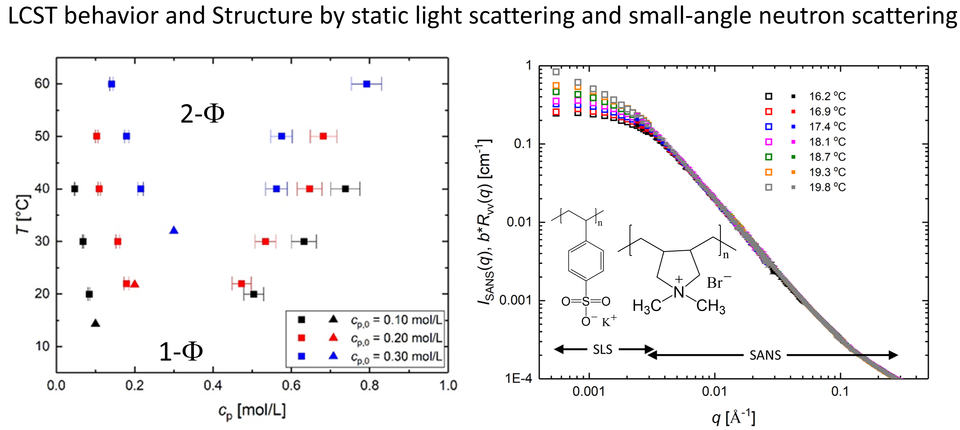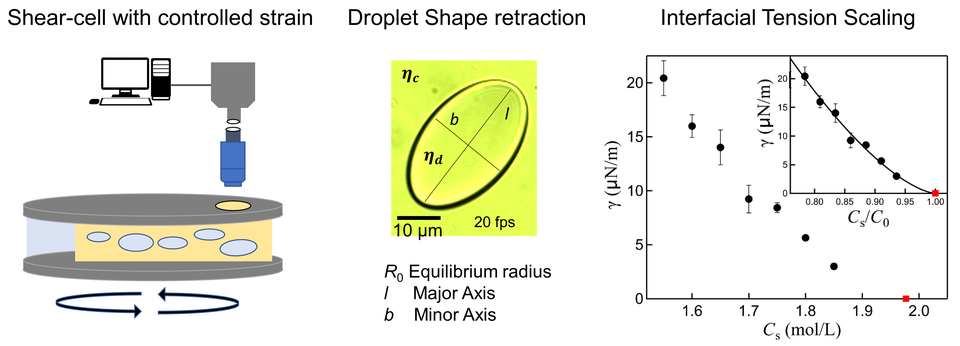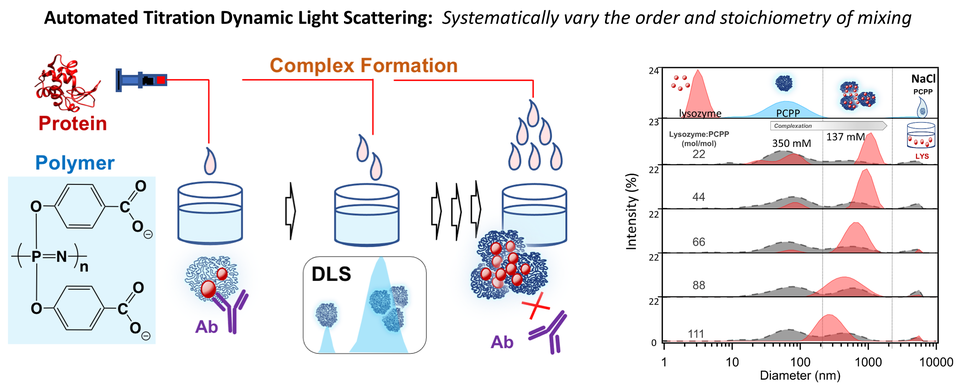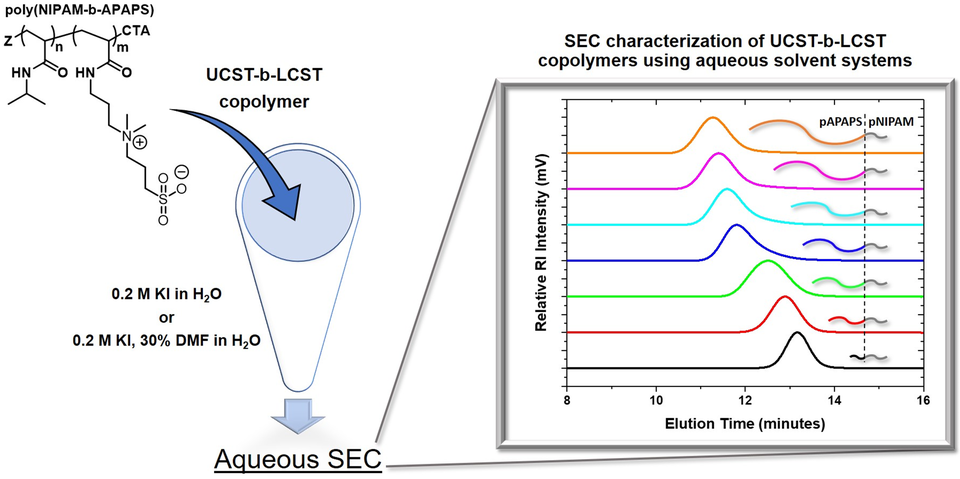Summary
We engage with leaders in the pharmaceutical, dental, and personal care research sectors that rely on water soluble polymers (polyelectrolytes) to develop new measurement and analysis methods for quantitative data that provide fundamentals for next-generation formulation design and processing technologies of these ion-containing polymeric materials.
Major Accomplishments
Associative Phase Separation of Charged Polymers
Phase Diagrams of Mixture of Oppositely-Charged Polyelectrolytes (Coacervates)
A temperature (T) versus polymer concentration (cp) representation leads to non-overlapping coexistence curves prepared from different initial polymer concentrations along a salt isopleth of aqueous mixtures of charge-stoichiometric, oppositely charged polydisperse polyelectrolytes. This effect was explained by a T-cs-cp phase envelope with phase separation upon heating (LCST). Using a combination of NMR, turbidity, static light scattering and small-angle neutron scattering the structure and stability of the solutions were quantified and illustrated a cross-over from mean-field to fluctuation regime behavior. Further, static light scattering measurements illustrate that concentration fluctuations are enhanced by polyelectrolyte chain association near the lower critical solution temperature, while the dynamics are described by the Generalized Stokes-Einstein equation and mode-mode coupling theory developed by Kawasaki and Ferrell.

Phase Diagrams of Polyzwiterions
A model zwitterionic polysulfobetaine, poly(3-(acrylamidopropyl-dimethyl-ammonium) propyl-1-sulfonate) (pAPAPS), phase separates upon cooling and exhibits an upper critical solution temperature (UCST) behavior with no added salt in deuterium oxide solutions. Dynamic light scattering measurements indicate the presence of distinct fast and slow diffusive modes, where the fast mode is interpreted as a collective diffusion coefficient and the slow mode is attributed to the diffusion of multi-chain dynamic clusters.

Interfacial Tension in Complex Coacervates
Dilute droplets form upon changing the temperature of a phase separated polyelectrolyte complex coacervate. This provides an in situ approach to measure the interfacial tension between supernatant (dilute droplet) and dense coacervate by the deformed drop retraction (DDR) method. The aqueous coacervate, formed via a model 1:1 by charge stoichiometric polyelectrolyte blend, exhibits ultralow interfacial tension with the coexisting phase. DDR finds the interfacial tension scales as γ=γ0 (1-Cs/Cs,c)μ, with μ = 1.5 ± 0.1, γ0 = 204 ± 36 μN/m, and Cs,c = 1.977 mol/L. The value of μ independently validates the classical exponent of 3/2. The scaling holds between Cs/Cs,c of 0.75 to 0.94, the closest measurements to date near the critical salt concentration (Cs,c).

Polyelectrolyte-Protein Complexes as Immunoadjuvant Formulations
Polyphosphazenes represent a class of intrinsically flexible polyelectrolytes with potent immunoadjuvant activity, which is enabled through non-covalent self-assembly with antigenic proteins by charge complexation. The formation of supramolecular complexes between polyphosphazene adjuvant, poly[di(carboxylatophenoxy)phosphazene (PCPP) and a model vaccine antigen, hen egg lysozyme, was studied under physiological conditions using automated dynamic light scattering titration, asymmetric flow field flow fractionation (AF4), enzyme-linked immunoassay (ELISA), and fluorescent quenching methods. Three regimes of self-assembly were observed covering complexation of PCPP with lysozyme in the nano-scale range, multi-chain complexes, and larger aggregates with complexes characterized by a maximum loading of over six hundred protein molecules per PCPP chain and dissociation constant in the micromolar range. The antigenicity of PCPP bound lysozyme, when compared to equivalent lysozyme solutions, was largely retained for all complexes, but observed a dramatic reduction for heavily aggregated systems.

Microphase Separation of Polyelectrolytes and Polyzwitterions
Block copolymers that exhibit both an upper critical solution temperature and a lower critical solution temperature are difficult to characterize due to inherent solubility difference between the two blocks. For example, accurate determination of both the molar mass and molar mass distribution is challenging for polyzwitterion-block-N-isopropyl acrylamide (NIPAM) copolymers in aqueous solutions due to self-assembly. A systematic methodology featuring aqueous SEC is demonstrated using several solvent conditions to enable the elution of polyzwitterion-block-NIPAM copolymers. These aqueous systems can be utilized for the characterization of similar water-soluble block copolymers that are relevant for drug delivery and other biomedical applications.

Kinetics of Associative Phase Separation
The observed droplet morphology of polyelectrolyte complexes finds many potential applications in materials as well as fundamentals of membranelles organelles. We discovered that common polyelectrolyte systems exhibit phase separation upon heating. This allowed a direct measurement of the temperature-induced phase separation and kinetics without any complications of the rates of mixing. The known spinodal and cloud point temperatures was essential to design such experiments, such that the spinodal wavelength was directly observed by a new small-angle laser light scattering instrument developed.

Samim Ali, Yimin Mao, and Vivek M. Prabhu, Pinhole mirror-based ultra-small angle light scattering setup for simultaneous measurement of scattering and transmission, Rev. Sci. Instrum. 93, 044104 (2022).
Yuanchi Ma, Samim Ali, Vivek M. Prabhu, Enhanced Concentration Fluctuations in Model Polyelectrolyte Coacervate Mixtures along a Salt Isopleth Phase Diagram, Macromolecules 54, 11338-11350 (2021).

